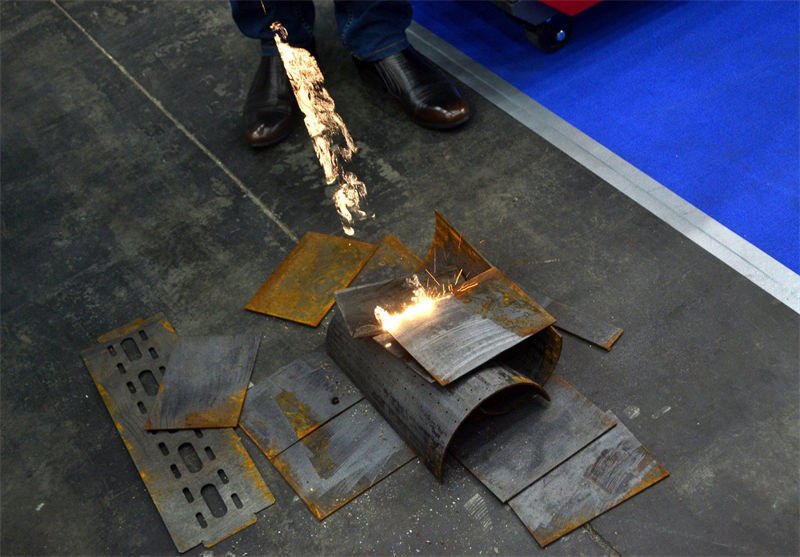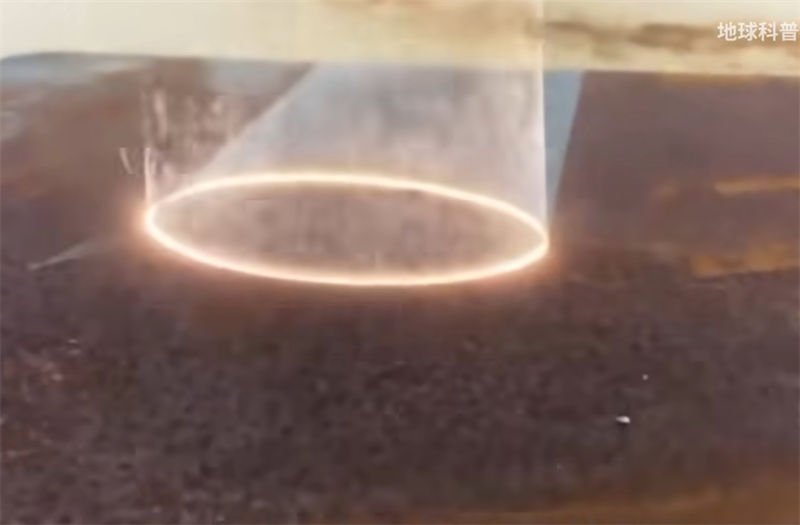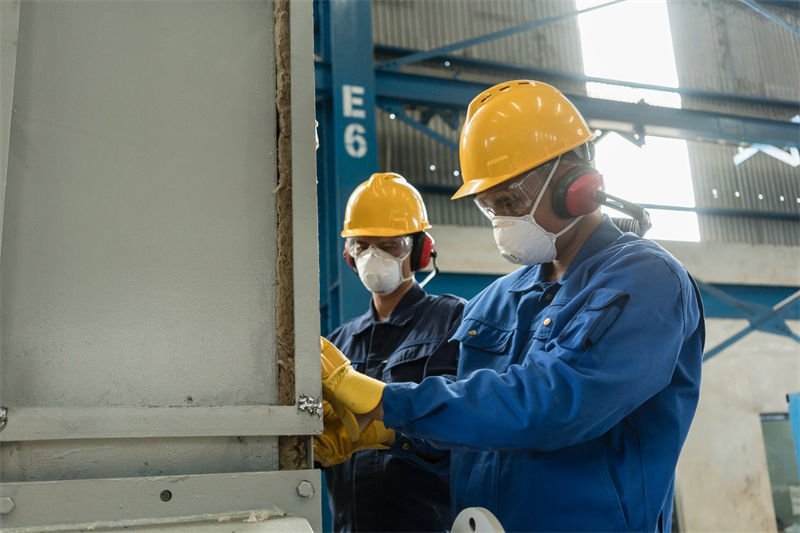
Thinking about giving your metal surfaces a fresh start with laser cleaning? Let’s dive into its safety together!
Laser cleaning is usually safe for metal surfaces under normal operation. It can remove contaminants with high precision. The laser beam can act precisely on impurities and cause little damage to the metal substrate. Moreover, it is non-contact and avoids mechanical contact damage. However, if the laser parameters are set unreasonably, such as excessive energy density, or if there is improper operation, such as uneven scanning speed, it may damage the metal surface, leading to problems such as overheating and changes in microstructure.
While laser cleaning offers distinct advantages like non-contact cleaning and precise control, understanding the parameters is vital to prevent any potential damage. In this guide, I’ll share valuable insights into safe practices, efficiency evaluations, and alternatives.
Laser cleaning is non-contact and eco-friendly.True
Laser cleaning uses light energy, avoiding physical contact and chemicals.
What Are the Key Benefits of Laser Cleaning for Metals?
Discover how laser cleaning revolutionizes metal maintenance with its precision and efficiency.
Metal laser cleaning has many advantages. It is a high-precision cleaning method that can accurately remove tiny pollutants without damaging the metal substrate. It is a non-contact cleaning method that can avoid scratches and deformations on the metal. At the same time, this cleaning method is environmentally friendly and pollution-free as it does not require chemical reagents. It is also highly efficient and convenient, capable of quickly cleaning large areas and selectively operating .

Enhanced Precision and Control
One of the standout benefits of laser cleaning is its ability to precisely target contaminants without affecting the underlying metal. This is achieved through careful calibration of laser parameters such as power, wavelength, and pulse duration. For instance, when cleaning rust off a stainless steel surface, the laser can be fine-tuned to remove only the rust without altering the smoothness of the metal. This precision ensures that delicate components, like aircraft engine blades, are not damaged during the cleaning process, thereby preserving their functionality and extending their lifespan.
Non-Contact and Non-Abrasive Cleaning
Traditional cleaning methods often involve mechanical abrasion or chemical solvents, which can introduce physical damage or leave residues on metal surfaces. In contrast, laser cleaning is a non-contact process, meaning there is no physical interaction between the cleaning tool and the metal. This eliminates the risk of scratches or surface wear, which is especially important for precision-engineered parts. For example, in the automotive industry, laser cleaning can efficiently remove paint layers from car bodies without damaging the underlying metal, thus maintaining the structural integrity of the vehicle components.
Environmentally Friendly Approach
With increasing environmental concerns, industries are moving towards sustainable practices. Laser cleaning is eco-friendly because it doesn’t rely on harsh chemicals that can contribute to pollution or require special disposal methods. Instead, it uses focused light energy to vaporize contaminants. This not only minimizes environmental impact but also reduces workplace hazards associated with chemical exposure.
Versatility Across Metals and Contaminants
Laser cleaning is not restricted to a single type of metal or contaminant. It can be used on various metals, including aluminum, steel, and copper, making it a versatile solution in industries ranging from aerospace to electronics. The method is effective against multiple contaminants such as rust, grease, paint, and oxides. For example, in electronics manufacturing, laser cleaning can be used to prepare metal surfaces by removing oxides that could interfere with electrical conductivity.
Increased Efficiency and Cost-Effectiveness
The efficiency of laser cleaning can be evaluated based on the area cleaned per unit time. Compared to traditional methods like chemical baths or abrasive blasting, laser cleaning often completes tasks more quickly while ensuring high-quality results. This speed advantage translates into cost savings by reducing labor hours and improving production throughput. In a comparison test between laser cleaning and mechanical grinding on a 10-square-meter steel plate, laser cleaning covered 8 square meters in an hour compared to 5 square meters by grinding.
Moreover, laser systems offer long-term stability and repeatability. Their ability to maintain consistent cleaning quality over extended periods makes them reliable for industrial applications. This repeatability is crucial for batch operations where predictability in cleaning time and quality enhances production efficiency.
| Benefit | Description |
|---|---|
| Precision | Targets only contaminants without damaging the substrate |
| Non-Contact | Eliminates risk of scratches or surface wear |
| Eco-Friendly | No use of harsh chemicals |
| Versatile | Applicable to various metals and contaminants |
| Efficient | Faster cleaning times with consistent quality |
Overall, laser cleaning stands out as a modern solution that not only enhances maintenance practices but also aligns with environmental and economic goals. Learn more about industrial laser applications1.
Laser cleaning is non-contact and non-abrasive.True
Laser cleaning avoids physical interaction, preventing scratches or wear.
Laser cleaning uses harsh chemicals for metal maintenance.False
It uses light energy, not chemicals, to clean metals.
How Can Improper Laser Settings Cause Damage to Metal Surfaces?
Improper laser settings can wreak havoc on metal surfaces, transforming a beneficial cleaning method into a source of damage.
Incorrect laser cleaning settings can damage metal surfaces in multiple ways. Excessive energy density can cause metal to overheat and even melt, destroying the original structure. Excessive heat conduction caused by unreasonable parameters can change the microstructure and affect the metal’s performance. At the same time, the thermal stress generated by uneven laser energy may cause cracks on the metal surface, and improper settings may also exacerbate oxidation and form a thick oxide layer.

The Role of Laser Parameters in Metal Safety
Laser cleaning hinges on the precise interaction between laser energy and metal surfaces. This precision ensures contaminants are removed without harming the underlying metal. However, when parameters like power, pulse duration, and scanning speed are set incorrectly, it can lead to detrimental effects.
Excessive Power
One of the most common issues is setting the laser power too high. Metals have a specific tolerance for energy absorption. Surpassing this limit can result in the melting and ablation of the surface. For instance, when dealing with thinner metal sheets, high power can create elevated local temperatures that alter the metal’s microstructure. This not only changes the hardness and roughness but can also form unsightly pits on the surface.
Table: Effects of Excessive Laser Power
| Metal Type | Potential Damage |
|---|---|
| Stainless Steel | Pitting, microstructure changes |
| Aluminum Alloy | Surface softening, discoloration |
Pulse Duration and Its Implications
Pulse duration is another critical factor, particularly for pulsed lasers. A prolonged pulse can elevate the temperature for an extended period, affecting the surface quality of heat-sensitive metals like aluminum alloys. This can lead to unwanted changes in material properties.
Operational Errors: Uneven Spot Distribution and Scanning Speed
Aside from parameter settings, operational errors also play a significant role. An uneven laser spot distribution can cause localized energy discrepancies. High-energy areas might undergo over-cleaning and suffer damage, while low-energy zones remain uncleaned. This unevenness is often due to optical system failures or miscalibrations.
Similarly, an inconsistent scanning speed affects how different parts of a metal surface absorb laser energy. Scanning too fast may leave contaminants behind, while moving too slowly can damage the surface due to excessive energy accumulation.
Ensuring Safe Laser Cleaning Practices
To prevent damage during laser cleaning, it’s imperative to customize laser parameters according to the specific type of metal and its surface contaminants. Regular maintenance of equipment and professional training for operators are also essential to maintain optimal performance.
Using methods such as direct measurement or comparison tests allows evaluation of cleaning efficiency and adjustments as needed. Implementing these practices ensures that laser cleaning remains a safe and effective method for maintaining metal surfaces.
Excessive laser power can cause metal surface melting.True
High laser power surpasses metal's energy absorption limit, causing melting.
Incorrect pulse duration has no effect on metals.False
Prolonged pulse durations can alter heat-sensitive metals' surface quality.
What Safety Precautions Should Be Taken During Laser Cleaning?
Laser cleaning is an innovative technique that promises efficiency and precision. Yet, understanding its safety is paramount.
During laser cleaning, operators need to wear professional laser protective glasses and protective clothing to protect eyes and skin. Have a good ventilation system to avoid inhaling smoke and dust. Inspect and maintain equipment to ensure normal operation. Also receive training and set up warning signs.

Understanding Laser Parameters
Correctly setting laser parameters is the first line of defense in ensuring safety during laser cleaning. The power, wavelength, and pulse duration should be tailored to the specific metal type and contaminants. For instance, using a laser with too much power can cause thermal damage2 to sensitive metals like aluminum alloys.
| Parameter | Potential Risk | Safety Measure |
|---|---|---|
| Excessive Power | Melting or Ablation | Adjust power to metal tolerance |
| Long Pulse | High-temperature Impact | Optimize pulse for material’s needs |
| Uneven Spot | Localized Over-cleaning | Regular optical system checks |
Operator Training and Equipment Maintenance
Professional training is crucial. Operators must understand the nuances of laser settings and their impacts. Regular equipment maintenance3 ensures that the optical systems are calibrated correctly, preventing uneven spot distribution that could lead to inconsistent cleaning results.
Monitoring Scanning Speed
Maintaining a stable scanning speed is essential to avoid energy accumulation or insufficient cleaning. A consistent speed prevents hot spots or incomplete cleaning, thus preserving the metal’s integrity. Using automated systems can help maintain uniform speed4 across the surface.
Environmental Safety Measures
Since laser cleaning can produce fumes and debris, adequate ventilation and protective gear are necessary. Implementing proper exhaust systems5 can significantly reduce exposure to harmful particles.
Importance of Material Assessment
Before beginning the cleaning process, assessing the material type and contaminant thickness is critical. This assessment guides parameter settings, ensuring that the laser energy targets contaminants without affecting the metal surface underneath. A thorough understanding of the material’s heat sensitivity helps in choosing the correct laser settings for optimal safety.
Operators must set laser parameters for each material type.True
Correct laser settings prevent damage and ensure safe cleaning.
Excessive laser power can cause thermal damage to all metals.False
Not all metals are equally sensitive; some withstand higher power.
Are There Alternatives to Laser Cleaning for Metal Surfaces?
Exploring alternatives to laser cleaning? Discover other effective methods for metal surface care.
In addition to laser cleaning of metal surfaces, there are chemical cleaning which uses chemical solvent reactions to remove scale but needs to prevent corrosion and handle waste liquid; mechanical cleaning such as sandblasting and grinding but it is easy to damage the surface; ultrasonic cleaning which utilizes cavitation; plasma cleaning which has a higher cost.

Chemical Cleaning: A Traditional Approach
Chemical cleaning involves using solvents or acids to remove contaminants from metal surfaces. This method is particularly effective for removing grease and oil residues6 but requires careful handling due to the hazardous nature of chemicals involved.
-
Benefits:
- Effective for stubborn residues.
- Can reach intricate parts and crevices.
-
Limitations:
- Risk of metal corrosion.
- Disposal of chemical waste is environmentally challenging.
Abrasive Blasting: Powerful Yet Intrusive
Abrasive blasting uses materials like sand or glass beads to physically remove rust or paint from surfaces. It’s ideal for heavy-duty cleaning tasks where surface roughness is acceptable.
-
Benefits:
- Quick removal of thick contaminants.
- Suitable for large surface areas.
-
Limitations:
- Can damage delicate surfaces.
- Generates dust and requires protective measures.
Ultrasonic Cleaning: Precision and Efficiency
Ultrasonic cleaning uses high-frequency sound waves in a liquid medium to dislodge contaminants from metal surfaces. It excels in precision cleaning tasks, especially for small or complex components.
-
Benefits:
- Non-abrasive and gentle on delicate parts.
- Effective in reaching hard-to-access areas.
-
Limitations:
- Limited to smaller parts due to equipment size constraints.
- Requires specific cleaning solutions for optimal results.
Comparing Alternatives: A Brief Overview
| Method | Main Advantage | Key Limitation |
|---|---|---|
| Chemical Cleaning | Effective on residues | Environmental impact |
| Abrasive Blasting | Fast for thick layers | Surface damage risk |
| Ultrasonic Cleaning | Gentle and precise | Size limitation |
Understanding these alternatives ensures you choose the most suitable method based on the type of contaminant, the surface material, and environmental considerations. Each option presents its own unique set of challenges and benefits, making it crucial to evaluate the specific needs of the project at hand. For further insights on optimizing these methods, explore our detailed comparison guide7.
Chemical cleaning is environmentally friendly.False
Chemical cleaning poses environmental challenges due to waste disposal.
Ultrasonic cleaning is suitable for large surfaces.False
Ultrasonic cleaning is limited to smaller parts due to equipment size.
Conclusion
With proper techniques and settings, laser cleaning can safely enhance your metal surfaces while promoting longevity and performance.
-
Explore diverse industrial uses for laser technology.: Laser cleaning can remove rust, oxides, paints, coats, electrolytes, and other contaminants from metal surfaces. Emerging applications include weld cleaning, … ↩
-
Explore how excessive laser power can cause thermal damage.: Hyper- and hypopigmentation after laser treatments are comparatively frequent complications, with hyperpigmentation occurring more commonly. The … ↩
-
Learn why regular maintenance is crucial for safe laser operations.: Proper maintenance and preemptive measures are essential for preserving the functionality and longevity of laser cleaning machines. Regular … ↩
-
Discover how automation maintains consistent scanning speeds.: It allows for precise scanning patterns, enabling uniform cleaning and coverage of the target area. ↩
-
Find out how exhaust systems mitigate harmful fume exposure.: Laser cutter exhaust systems extract and expel these toxic fumes responsibly, keeping the workers and environment safe. Laser cutting produces … ↩
-
Learn effective chemical cleaning techniques for removing stubborn residues.: Water-based degreasing involves using water and biodegradable detergents to remove grease and oil from metal surfaces. ↩
-
Explore a comprehensive analysis of various cleaning methods.: The difference between laser cleaning and ultrasonic cleaning is that the laser cleaning operation is very convenient. Generally, hand-held cleaning is … ↩




